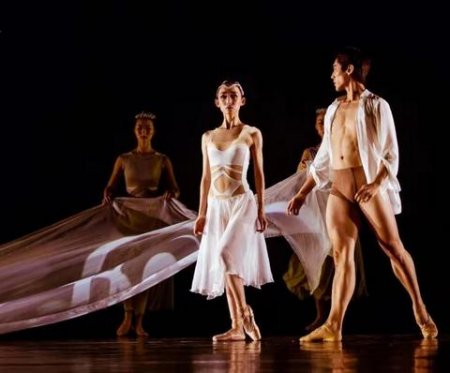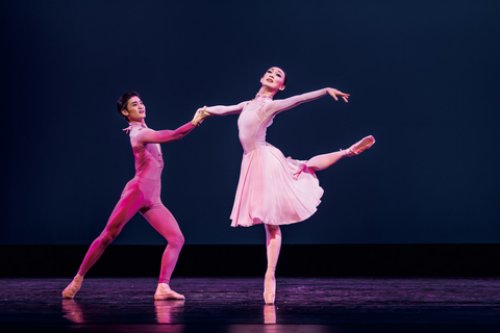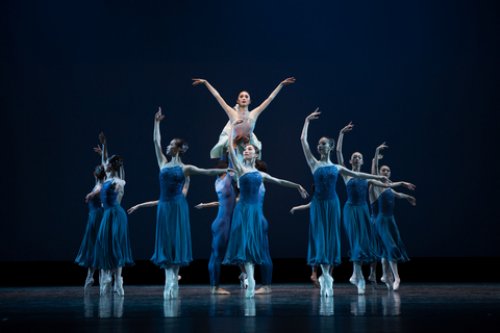Guangzhou Ballet of China: “Carmina Burana” & “Goddess of the Luo River”
A large ballet troupe from China brings spectacle without depth in two dance events, a classic and an unfamiliar work.

A scene from Guangzhou Ballet of China’s production of Jiang Qi’s “Goddess of the Luo River” (Photo credit: Courtesy of Guangzhou Ballet of China)
[avatar user=”Joel Benjamin” size=”96″ align=”left” ] Joel Benjamin, Critic[/avatar]
Take away the Guangzhou Ballet of China’s brilliant production elements—colorful costumes by Anne Armit, audacious scenic design by Han Jiang and mood-enhancing lighting by Chen Xiaji—and what is left is a decent but not world-class ballet troupe (Zou Gang, Artistic Director).
Presented at Lincoln Center’s David H. Koch Theater by the China Arts and Entertainment Group Ltd., the company used its impressive resource of dancers in two large-scale ballets: Goddess of the Luo River choreographed by the Canadian, Peter Quanz to a Western-sounding violin concerto by the Chinese composer Du Mingxin and Carmina Burana choreographed by the Chinese-American Jiang Qi to the famous (infamous?) score by Carl Orff.
The former was a run-of-the-mill ballet weighed down by fuzzily pretentious program notes. Three characters—Yi Ren (Fang Afang), Lian Jun (Huang Baimao) and Ruo Shui (Ma Minghao)—led the corps de ballet in several merry chases that involved processions, movements rolling down lines of dancers, non-romantic encounters and show-off solos by the male contingent, all ending in a pretty arrangement of the dancers across the Koch stage with one of the characters held imposingly high as if overlooking her kingdom.

A scene from Guangzhou Ballet of China’s production of Jiang Qi’s “Carmina Burana” (Photo credit: Courtesy of Guangzhou Ballet of China)
Somehow Jiang Qi missed the entire thrust of Carmina Burana, whose texts are teeming with ribald sexual innuendo, and turned it into a ballet about spiritual salvation with a cast of artificial characters shoehorned into the very familiar score (which has been used for choreography many, many times over the decades).
In Jiang’s interpretation of this still-stirring score—a recording—a love affair between Helena (Zhou Yu) and Bolanzifaluo (Kou Zuquan) which began in “The Spring” went awry when Helena ran off to enjoy life. This led eventually to the two sacrificing themselves, but not until they are confronted by Kety (Huang Ping) and Crace (Zhang Weiwei) in a change-partners-and-dance-with-me scene at “The Tavern.” Finally, in “Destiny” at least according to the program notes, it all led to the earth dying and drying up. Finally, the two main leads committed suicide and hope was reborn.
The trouble is that Jiang, even helped by the ever-changing scenery, projections and costumes, failed to communicate any of this in his steps. The closest he got to expressing real emotion was the dejection shown by the two lovers when they cheated on each other. He efficiently managed the corps de ballet, but the soloists and their confrontations were awkward and artificial.

A scene from Guangzhou Ballet of China’s production of Jiang Qi’s “Carmina Burana” (Photo credit: Courtesy of Guangzhou Ballet of China)
The Guangzhou dancers were more than competent, duly performing the choreography with precision if not passion. They seemed to put all their efforts into dancing the steps as well as they could, like exceptionally lovely beings, but without adding any individuality, emotion or style. This was generically well-danced ballet that—hindered by clichéd choreography—generated excitement on the most superficial level.
One last observation: It would have been a good idea if someone familiar with English had edited the program notes which were almost totally unintelligible.
Guangzhou Ballet of China (August 17-18, 1029)
China Arts and Entertainment Group Ltd.
David H. Koch Theater, Lincoln Center for the Performing Arts, in Manhattan
For tickets, call 212-496-0600 or visit http://www.DavidHKochTheater.com
Running time: two hours including one intermission






Leave a comment